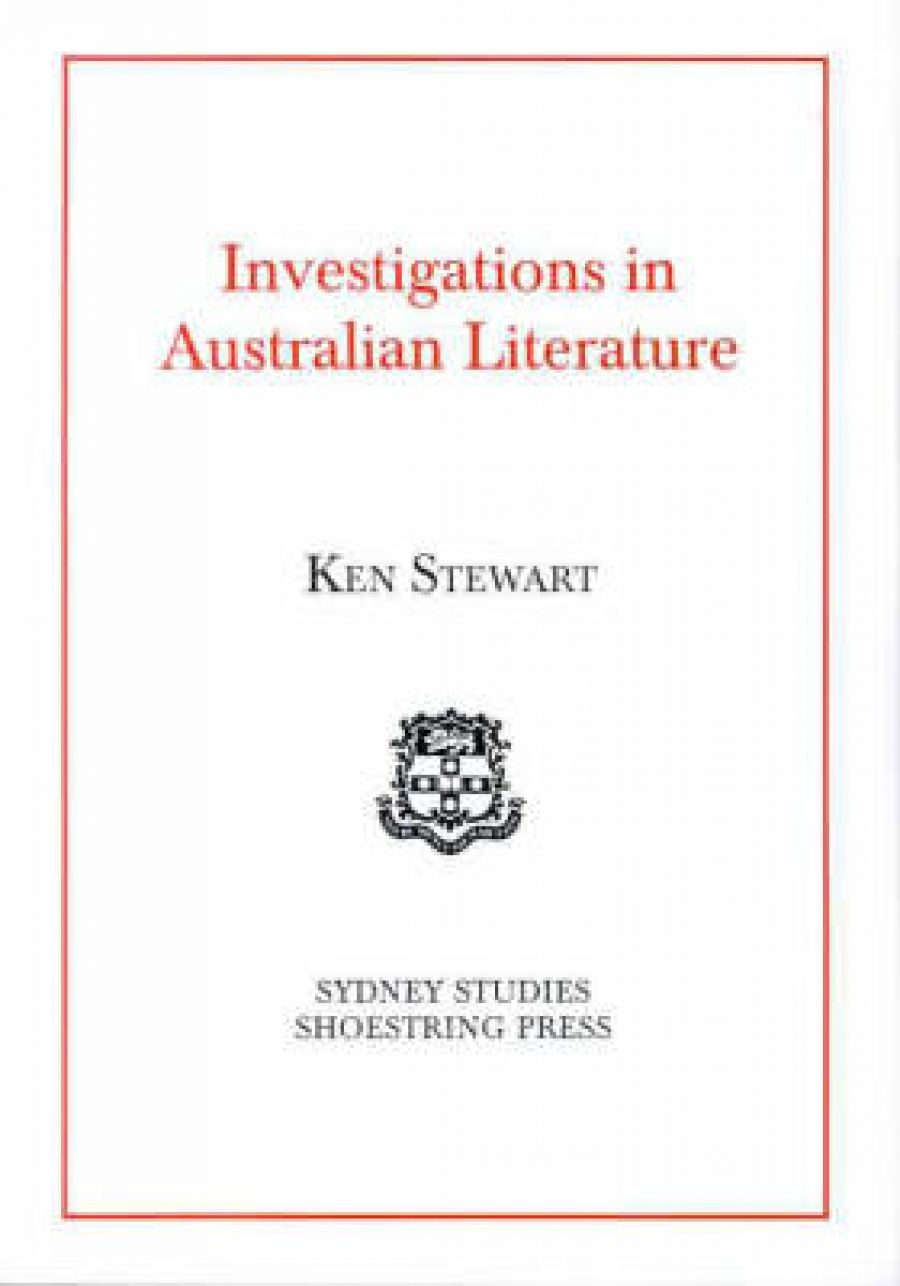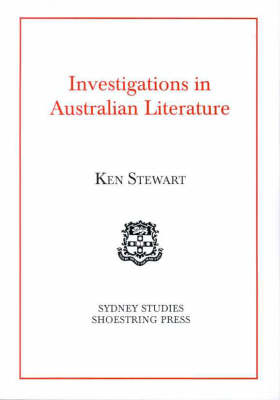
- Free Article: No
- Review Article: Yes
- Article Title: Critically Acute
- Online Only: No
- Custom Highlight Text:
No more critically acute or challenging collection of essays on the subject has been published than Ken Stewart’s modestly titled Investigations in Australian Literature. Yet the author’s personality is not similarly subdued. The Stewart known in person to many readers of ABR emerges unselfconsciously: erudite but undogmatic, rueful and witty, a touch dishevelled, one of the most beguiling and persuasive of teachers about Australia and its literature. We are fortunate that – through the agency of the admirable Shoestring Press – this volume exists to demonstrate the coherence, conceptual clarity, and spirit of delight that imbues Stewart’s criticism of much that has been written here, at least to the middle of the century.
- Book 1 Title: Investigations in Australian Literature
- Book 1 Biblio: Shoestring Press pb, 205 pp
- Book 1 Cover Small (400 x 600):

- Book 1 Cover (800 x 1200):

It is a challenge to which Stewart rises in the first three essays of this book: on ‘The Cultural Missionaries, 1855–1916’; the Melbourne theatre critics, James Smith and James Neild; and the miserable (for him) but culturally significant eighteen months that Henry Kendall spent in that city as ‘A Careworn Writer for the Press’. Some of the insights that Stewart has developed from his research are well on their way to becoming commonplaces which – no doubt – he will seek to complicate in good time. Thus he has argued how – in the later decades of last century – ‘literary Australia was largely journalists’ Australia’; that ‘the colonial literati themselves … helped to create the legend of the neglected artist in a practical, sports-minded community’; that’ a high proportion of the most influential city journalists of the 1880s … were previously editors or associates of country newspapers’. We could go on, for instance with Stewart’s discussion of a ‘critical nationalism’ in which writers recognised a purpose (which, at a distance, can seem dreary and dutiful) ‘to explore ethical and spiritual realities and ideals on behalf of the emerging and potentially wayward nation’.
From everything on which Stewart’s glance falls we gain illumination and surprise. For example he contends that – before Paterson – the most popular verse in Australia (ballads) ‘was unpublished, and the most unpopular was published’. Those who have trudged through colonial newspapers and slim, self-published volumes of verse will concur. He writes of the games played according to the rules that Bulletin readers shared with its commentators, writers, and illustrators, ‘wryness, toughness, pith, grim understatement and insouciant irreverence’ their features; he considers the ‘great Hamlet controversy’ of 1867 in Melbourne – well, was he mad or not? This was a society whose members took that literary issue, and its own considered opinions, seriously.
If colonial society also felt that its British parent culture warranted emulation, and that no Australian Shakespeare had yet emerged, still it had a vigour and self-confidence that emphasis on the 1890s as a proto-nationalist watershed has obscured. ‘The 1890s’ is a concept that essentially confuses literary with political chronologies. As Stewart notes in his long review of Cecil Hadgraft’s The Australian Short Story Before Lawson, ‘One of the hardest-dying legends about the nineties is the belief that the Australian short story virtually began with Henry Lawson’. More generally, he asserts, ‘Colonial literary Victorianism was as diverse, dynamic and enigmatic as its English counterpart’. There is no special pleading here, rather a call to regard more astringently what we loosely call Australian literature, and to do so with more respect.
Shirking not even the hardest, because most familiar confrontations, Stewart is perhaps at his best on Lawson. He offers a virtuoso re-reading of the much-loved comic tale, ‘The Loaded Dog’, which hitherto has seemed beyond and above literary scrutiny. This exercise gives Stewart the chance to define salient qualities of Lawson’s work, as he describes them: ‘human gregariousness’ and ‘the hardness of things’. The dog itself, in this ‘Celebration’, becomes ‘the gregarious impulse incarnate, canonised and canine-ised’. For what else goes on in the essay, we can forgive him that flourish. Reviewing biographies of Lawson and Furphy by Colin Roderick and John Barnes respectively, Stewart praises ‘an assiduous empiricism in plain prose’ that they share, and enjoys Roderick’s demolition of compelling legends, for example of Lawson as ‘the reliable mate who was born in a tent and died in the toilet’. At the same time he wants to free Lawson from a too controlling exegesis, saying memorably that ‘Lawson helped to forge his own chains, but it should be possible to concede that he sang in them’.
There is much more, each essay reinforcing what has gone before, each fresh, for all that most have already been published – on Clarke’s His Natural Life, on Stead’s The Man Who Loved Children (a novel once so well known that few people now know it at all), on Richardson, who features in three essays, one of which incites us to consider whether more grog is consumed (by minor characters) in any other Australian novel than The Fortunes of Richard Mahony? What does it amount to? What has been investigated and with what results? These, I think: Stewart has subsumed the most scrupulous scholarship within a humane, ambitious, loving endeavour to discern the labours of heart and mind that produced an Australian literature and a culture to reckon with it between 1850–1940. We will better understand that other country, the past, but also this one, because of what Ken Stewart has so daringly, yet disarmingly ventured to investigate.


Comments powered by CComment